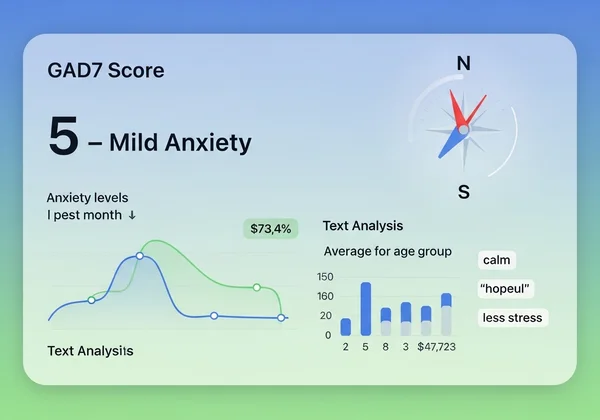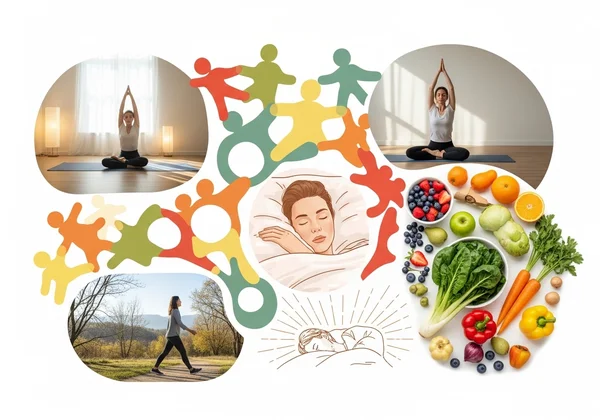GAD7: Craft Your Personalized Anxiety Action Plan
You've taken the first brave step: you completed the GAD7 assessment and received your score. A number sits on your screen, reflecting your recent experiences with anxiety. But what should I do after getting my GAD7 score? This is the most common and crucial question. Understanding your score is just the beginning. This guide will empower you to move beyond the numbers and create a concrete, personalized plan for managing your anxiety symptoms. You're taking charge of your mental well-being. Let's begin your journey to clarity by helping you understand your baseline with a free assessment.
Understanding Your GAD7 Score & AI Insights
Your GAD7 score is a valuable snapshot of your anxiety symptoms over the past two weeks. It's a scientifically validated starting point helping to quantify feelings that can often seem overwhelming and abstract. Think of it not as a label, but as a compass pointing you toward understanding and action. This initial GAD7 score provides a foundation upon which you can build a truly effective plan.
Interpreting Your GAD7 Score Ranges
The GAD7 questionnaire total score ranges from 0 to 21. These scores are generally interpreted as follows, providing a framework for your next steps:
- 0-4: Minimal Anxiety. Your symptoms are likely not causing significant distress. This is a good time to focus on maintaining healthy habits.
- 5-9: Mild Anxiety. You may be experiencing some symptoms of anxiety. This is an ideal stage to implement self-care strategies and monitor your feelings.
- 10-14: Moderate Anxiety. Your symptoms are likely causing noticeable distress in your daily life. It’s important to actively develop coping strategies, and you may want to consider speaking with a professional.
- 15-21: Severe Anxiety. At this level, anxiety is likely causing significant impairment. Seeking professional support is strongly recommended.
Remember, this score is a tool for awareness. It's not a judgment. It's information that you can use to build a path forward.
The Power of Your Personalized AI Anxiety Report
While the score gives you a category, true progress comes from personalization. This is where modern tools can make a significant difference. Unlike a static number, a personalized AI anxiety report can transform your score into a dynamic roadmap. By answering a few additional background questions, our unique AI tool analyzes your specific symptom patterns, potential triggers, and lifestyle factors.
This report doesn't just tell you what your score is; it helps explain why. It can highlight your personal strengths, identify potential challenges, and offer actionable steps tailored to your unique situation. This deeper insight is invaluable for crafting a plan that truly resonates with your life. You can explore the AI report to see how it works.

Developing Effective Anxiety Coping Strategies
Once you have a clearer picture of your anxiety, you can begin building a toolkit of effective coping strategies. These are techniques you can turn to in the moment to manage overwhelming feelings and reduce their intensity. The goal is not to eliminate anxiety entirely—it's a normal human emotion—but to prevent it from controlling your life.
Mindfulness and Relaxation Techniques for Anxiety
One of the most powerful tools for managing anxiety is grounding yourself in the present moment. Anxious thoughts often pull us into worrying about the future or ruminating on the past. Mindfulness and relaxation techniques bring you back to the here and now.
- Deep Breathing: When you feel anxious, your breathing often becomes shallow and rapid. Practice the 4-7-8 technique: inhale through your nose for 4 seconds, hold your breath for 7 seconds, and exhale slowly through your mouth for 8 seconds. This simple exercise can calm your nervous system almost instantly.
- 5-4-3-2-1 Grounding: Engage your senses to pull your focus away from anxious thoughts. Identify 5 things you can see, 4 things you can touch, 3 things you can hear, 2 things you can smell, and 1 thing you can taste.
- Progressive Muscle Relaxation: Tense and then release different muscle groups throughout your body, from your toes to your head. This practice helps you recognize and release physical tension associated with anxiety.
Challenging Anxious Thoughts with Cognitive Tools
Anxiety is often fueled by negative thought patterns or cognitive distortions. Learning to recognize and challenge these thoughts is a core component of Cognitive Behavioral Therapy (CBT), one of the most effective treatments for anxiety disorders. You don't need to be a therapist to start using these cognitive tools.
When you feel an anxious thought arise, ask yourself a few critical questions:
- Is this thought 100% true?
- Is there a more positive or realistic way to view this situation?
- What is the worst thing that could happen, and could I handle it?
- What advice would I give a friend who had this same thought?
By questioning your thoughts, you create distance from them and reduce their power. This is a key skill for long-term daily anxiety management.

Integrating Daily Anxiety Management for Sustained Well-being
In-the-moment coping strategies are essential, but a sustainable plan also involves building daily habits that promote overall mental well-being. These lifestyle adjustments create a strong foundation that makes you more resilient to stressors when they arise. Integrating these practices can transform your approach from reactive to proactive.
Lifestyle Adjustments to Reduce Anxiety Symptoms
Small, consistent changes in your daily routine can have a profound impact on your anxiety levels. These lifestyle adjustments support both your mental and physical health, which are deeply interconnected.
- Prioritize Sleep: Lack of sleep is a major trigger for anxiety. Aim for 7-9 hours of quality sleep per night. Create a relaxing bedtime routine and make your bedroom a screen-free zone.
- Nourish Your Body: A balanced diet can stabilize your mood. Limit caffeine, sugar, and processed foods, which can exacerbate anxiety symptoms. Focus on whole foods like fruits, vegetables, lean proteins, and complex carbohydrates.
- Move Your Body: Regular physical activity is a powerful anxiety reducer. Aim for 30 minutes of moderate exercise most days of the week. This could be a brisk walk, a bike ride, yoga, or dancing—find something you enjoy!
Building Your Support Network & Setting Healthy Boundaries
You don't have to manage anxiety alone. Connection is a fundamental human need and a powerful antidote to worry. Your support network can include friends, family, partners, or support groups. Sharing your feelings with someone you trust can lift a significant weight.
Equally important is setting healthy boundaries. This means learning to say "no" to commitments that drain your energy and protecting your time for rest and self-care. Boundaries are not selfish; they are a necessary component of mental wellness and a key part of your personalized anxiety plan. Getting a clear picture with a GAD7 assessment can be the first step in identifying where you need to set these boundaries.

Knowing When to Seek Professional Support
Self-help strategies are incredibly effective, but it’s also vital to recognize when you might need more support. There is immense strength in asking for help. A mental health professional, such as one you can find through the National Alliance on Mental Illness (NAMI), can provide a formal diagnosis, offer evidence-based therapies, and work with you to create a comprehensive treatment plan.
Recognizing Signs for Professional Intervention
Consider seeking professional support if you experience any of the following:
- Your anxiety is significantly interfering with your work, school, or relationships.
- Your symptoms are persistent and causing you severe distress.
- You are struggling to manage your anxiety with self-help strategies alone.
- You are using unhealthy coping mechanisms like substance use to manage your feelings.
A healthcare provider can help you navigate these challenges and provide the expert guidance you need. An initial anxiety self-assessment can provide valuable information to share with them.
How Our Platform Can Guide Your Next Steps with AI Insights
Your GAD7 score and AI-powered report can be a fantastic bridge to a professional conversation. Instead of just saying "I feel anxious," you can share your specific score, the symptoms that are most frequent, and the personalized insights from your report. This provides a clear, data-informed starting point for a productive discussion with a doctor or therapist. It helps them understand your experience more quickly and thoroughly.

Empowering Your Journey: Take Control of Your Anxiety
Receiving your GAD7 score is not the end of a process; it is the beginning of an empowered journey. By understanding what your score means, leveraging personalized insights, developing coping strategies, and making sustainable lifestyle changes, you can create an effective action plan. You have the power to move from worry to well-being.
Take the next step today. If you haven't already, take the free GAD7 test on our homepage. If you have your score, consider exploring the personalized AI report to build the foundation for your unique action plan. Share this guide with anyone you think might benefit, and let's take control of our mental health, together.
Frequently Asked Questions About GAD7 & Your Action Plan
What should I do after getting my GAD7 score?
Your first step is to understand what the score indicates by looking at the mild, moderate, or severe ranges. Next, use this information to build an action plan. This could involve implementing self-care strategies, exploring the deeper insights from a personalized report on our platform, and, if your score is high or you're concerned, scheduling a conversation with a healthcare professional.
How accurate is the GAD7 test for self-assessment?
The GAD7 is a highly reliable and scientifically validated screening tool used by clinicians worldwide to help detect and monitor anxiety symptoms. While it is very accurate for screening purposes, it is important to remember that it is not a diagnostic tool. A formal diagnosis can only be made by a qualified healthcare professional.
Is the GAD7 a diagnosis of generalized anxiety disorder?
No, the GAD7 is a screening tool, not a diagnosis. A high score suggests that you have symptoms consistent with Generalized Anxiety Disorder (GAD) and should speak with a doctor or mental health professional. They can conduct a comprehensive evaluation to provide an accurate diagnosis and discuss treatment options.
What are the best daily practices to reduce anxiety?
The most effective daily practices often include regular exercise, a balanced diet, consistent sleep, and mindfulness or meditation. Additionally, practicing gratitude and engaging in hobbies you enjoy can significantly improve your resilience to anxiety. The key is consistency and finding what works best for you.
How does a personalized anxiety action plan differ from general advice?
General advice provides a broad foundation, but a personalized plan is far more powerful. It considers your specific GAD7 score, your unique symptoms, lifestyle, and potential triggers. The AI-powered report available after our free online GAD7 test is designed to provide this level of personalization, offering actionable steps that are tailored directly to your individual experience for a more effective outcome.